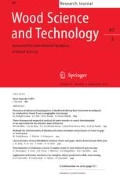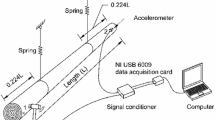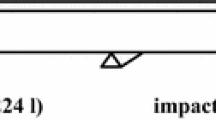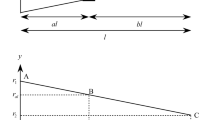Abstract
A number of studies have shown the ability of the vibration resonant method (VRM) to measure the modulus of elasticity (MOE) and the damping ratio (\(\xi\)) of calibrated wooden samples of various dimensions. This method based on free transverse vibrations was also studied to assess the decay extent in small stakes. Nevertheless, a need for investigations was identified in order to apply the method to decayed logs. Both decay and geometrical singularities brought heterogeneity not taken into account by the VRM. The aim of this study was to examine the effects of fungal decay on these two mechanical properties of small-diameter silver fir logs using the VRM. Fifty-five small-diameter logs were monitored over a decay process taking place in a greenhouse located near Grenoble (France). The MOE and \(\xi\) were measured in intact and decayed states. The results showed the reliability of the measurements of both properties. \(\xi\) was found to be independent of moisture content for wood above the fibre saturation point. The results validated the loss in MOE and the gain in \(\xi\) due to fungal activity. Thus, indicators based on the MOE and \(\xi\) were proposed and compared to quantify the decay extent. Indicators calculated from the first mode of vibration appeared to be relevant for that purpose. Future work is needed to validate indicators on structural size logs and to compare this quantitative assessment to those obtained by the standard EN 152 that currently serves as a benchmark.











Similar content being viewed by others
References
Alfredsen G, Larnoy E, Militz H (2006) Dynamic MOE testing of wood: the influence of wood protecting agents and moisture content on ultrasonic pulse and resonant vibration. Wood Res 51(1):11–20
Barré JB, Bourrier F, Cécillon L, Brancheriau L, Bertrand D, Thévenon MF, Rey F (2017) Predicting mechanical degradation indicators of silver fir wooden strips using near infrared spectroscopy. Eur J Wood Prod. doi:10.1007/s00107-017-1209-4
Barrett JD, Hong JP (2009) Moisture content adjustments for dynamic modulus of elasticity of wood members. Wood Sci Technol 44(3):485–495
Brancheriau L (2002) Expertise mecanique des sciages par analyses des vibrations dans le domaine acoustique (Dynamic analysis of sawing wood for strength grading). Ph.D. thesis, Université de la Méditerranée - Aix-Marseille II (In French)
Brancheriau L, Bailleres H (2002) Natural vibration analysis of clear wooden beams: a theoretical review. Wood Sci Technol 36(4):347–365
Brischke C, Rapp AO (2008) Influence of wood moisture content and wood temperature on fungal decay in the field: observations in different micro-climates. Wood Sci Technol 42(8):663
Bucur V (2006) Acoustics of wood. Springer, Berlin
CEN (2003) EN 14251:2003. Structural round timber. Test methods. Technical report, Brussels, Belgium
CEN (2006) EN 15083-1:2005. Determination of the natural durability of solid wood against wood-destroying fungi—test methods. Technical report, Brussels, Belgium
CEN (2014) EN 252:2013. Field test method for determining the relative protective effectiveness of a wood preservative in ground contact. Technical report, CEN, Brussels, Belgium
Cirad (2015) Tropix 7 version 7.5.1. doi:10.18167/74726f706978
Cruz H, Yeomans D, Tsakanika E, Macchioni N, Jorissen A, Touza M, Mannucci M, Loureno P (2015) Guidelines for on-site assessment of historic timber structures. Int J Archit Herit 9(3):277–289
Curling S, Clausen C, Winandy J (2002) Relationships between mechanical properties, weight loss, and chemical composition of wood during incipient brown-rot decay. Forest Prod J 52(7–8):34–39
De Silva CW (ed) (2005) Vibration and shock handbook. Mechanical engineering series. Taylor & Francis, Boca Raton
Dunlop JI (1983) Testing of poles by acoustic resonance. Wood Sci Technol 17(1):31–38
Gibson RF (1989) Vibration-test methods for dynamic-mechanical-property characterization. In: Pendleton RL, Tuttle ME (eds) Manual on experimental methods for mechanical testing of composites. Springer, Berlin, pp 151–164
Green D, Gorman T, Evans J, Murphy J (2006) Mechanical grading of round timber beams. J Mater Civ Eng 18(1):1–10
Grinda M, Göller S (2005) Some experiences with stake tests at BAM test fields and in the BAM fungus cellar. Part 1: Comparison of results of visual assessments and determinations of static modulus of elasticity (MOE). Document IRG/WP 05-20319. International Research Group on Wood Protection, p 28
Haines D, Leban JM, Herb C (1996) Determination of Young’s modulus for spruce, fir and isotropic materials by the resonance flexure method with comparisons to static flexure and other dynamic methods. Wood Sci Technol 30(4):253–263
Holz D (1996) Tropical hardwoods used in musical instruments—can we substitute them by temperate zone species? Holzforschung 50(2):121–129
Kretschmann D (2010) Mechanical properties of wood. In: Ross R (ed) Wood handbook: wood as an engineering material, chap 5. U.S. Department of Agriculture, Forest Service, Forest Products Laboratory, Madison
Labonnote N, Ronnquist A, Malo KA (2013) Experimental evaluations of material damping in timber beams of structural dimensions. Wood Sci Technol 47(5):1033–1050
Lundström T, Stoffel M, Stöckli V (2008) Fresh-stem bending of silver fir and Norway spruce. Tree Physiol 28(3):355–366
Machek L, Militz RH, Sierra A (2001) As the influence of wood moisture content on dynamic modulus of elasticity measurements in durability testing. Holzforschung Holzverwertung 53(5):97–100
Niklas KJ, Spatz HC (2010) Worldwide correlations of mechanical properties and green wood density. Am J Bot 97(10):1587–1594
Noetzli K, Boell A, Graf F, Sieber T, Holdenrieder O (2008) Influence of decay fungi, construction characteristics, and environmental conditions on the quality of wooden check-dams. Forest Prod J 58(4):72–79
Obataya E, Norimoto M, Gril J (1998) The effects of adsorbed water on dynamic mechanical properties of wood. Polymer 39(14):3059–3064
Ouis D (1999) Vibrational and acoustical experiments on logs of spruce. Wood Sci Technol 33(2):151–184
Ouis D (2000) Detection of decay in logs through measuring the dampening of bending vibrations by means of a room acoustical technique. Wood Sci Technol 34(3):221–236
Previati M, Canone D, Bevilacqua I, Boetto G, Pognant D, Ferraris S (2012) Evaluation of wood degradation for timber check dams using time domain reflectometry water content measurements. Ecol Eng 44:259–268
R Core Team (2016) R: a language and environment for statistical computing. R Foundation for Statistical Computing, Vienna, Austria. https://www.R-project.org/
Riggio M, Anthony RW, Augelli F, Kasal B, Lechner T, Muller W, Tannert T (2013) In situ assessment of structural timber using non-destructive techniques. Mater Struct 47(5):749–766
Sandak A, Sandak J, Riggio M (2015) Assessment of wood structural members degradation by means of infrared spectroscopy: an overview. Struct Control Health Monit. doi:10.1002/stc.1777
Signal Developers (2015) Signal: signal processing. http://r-forge.r-project.org/projects/signal/
Stapel P, van de Kuilen JWG (2013) Effects of grading procedures on the scatter of characteristic values of European grown sawn timber. Mater Struct 46(9):1587–1598
Tannert T, Anthony RW, Kasal B, Kloiber M, Piazza M, Riggio M, Rinn F, Widmann R, Yamaguchi N (2013) In situ assessment of structural timber using semi-destructive techniques. Mater Struct 47(5):767–785
Thomson WT, Dahleh MD (1998) Theory of vibration with applications, 5th edn. Prentice Hall, Upper Saddle River
Verkasalo E, Leban JM (2002) MOE and MOR in static bending of small clear 520 specimens of Scots pine, Norway spruce and European fir from Finland and France and their prediction for the comparison of wood quality. Paperi ja Puu/Paper and Timber 84(5):332–340
Wang X, Ross R, Mattson J, Erickson J, Forsman J, Geske E, Wehr M (2002) Nondestructive evaluation techniques for assessing modulus of elasticity and stiffness of small-diameter logs. Forest Prod J 52(2):79–85
Williamson GB, Wiemann MC (2010) Measuring wood specific gravity..correctly. Am J Bot 97(3):519–524
Woodhouse J (1998) Linear damping models for structural vibration. J Sound Vib 215(3):547–569
Yeh CT, Hartz BJ, Brown CB (1971) Damping sources in wood structures. J Sound Vib 19(4):411–419
Zabel RA, Morrell JJ (1992) Wood microbiology: decay and its prevention. Academic Press, San Diego
Acknowledgements
This work has been financed within the framework of Arc Environnement (Rhône Alpes Region, France).
Author information
Authors and Affiliations
Corresponding author
Rights and permissions
About this article
Cite this article
Barré, J.B., Bourrier, F., Brancheriau, L. et al. Effects of fungal decay on elasticity and damping of small-diameter silver fir logs assessed by the transverse vibration resonant method. Wood Sci Technol 52, 403–420 (2018). https://doi.org/10.1007/s00226-017-0961-2
Received:
Published:
Issue Date:
DOI: https://doi.org/10.1007/s00226-017-0961-2




